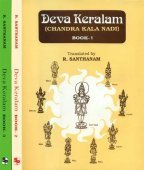Grahas: 1 definition
Introduction:
Grahas means something in Hinduism, Sanskrit. If you want to know the exact meaning, history, etymology or English translation of this term then check out the descriptions on this page. Add your comment or reference to a book if you want to contribute to this summary article.
Images (photo gallery)
In Hinduism
Purana and Itihasa (epic history)
Source: archive.org: Puranic EncyclopediaGrahas (ग्रहस्).—(planets) Indians from very ancient days have maintained certain definite ideas and inferences about the planets. Though those ideas differ somewhat from the results of modern researches, the influence of the ancient ideas is discernible in all the Purāṇic texts in India. The main ideas are summarised below.
Sūrya (Sun), Candra (Moon), Śukra (Venus), Budha (Mercury), Kuja (Mars), Bṛhaspati (Jupiter), Śani (Saturn), Rāhu and Ketu are the navagrahas (the nine planets). (See full article at Story of Grahas from the Puranic encyclopaedia by Vettam Mani)

The Purana (पुराण, purāṇas) refers to Sanskrit literature preserving ancient India’s vast cultural history, including historical legends, religious ceremonies, various arts and sciences. The eighteen mahapuranas total over 400,000 shlokas (metrical couplets) and date to at least several centuries BCE.
See also (Relevant definitions)
Starts with (+8): Grahasadhana, Grahasamagama, Grahasamaya, Grahasamgraha, Grahasana, Grahasangama, Grahasarani, Grahasarini, Grahashamke, Grahashanti, Grahashantipaddhati, Grahashantividhi, Grahashi, Grahashin, Grahashraya, Grahashringataka, Grahashringatika, Grahashtaka, Grahashtakabrahmana, Grahasiddhanta.
Full-text (+130): Graha, Brihaspati, Shanaishcara, Shukra, Atigraha, Grahapuja, Apaka, Shodashigraha, Dhruvagopa, Grahakanda, Gochara, Kusha, Udumbara, Pippala, Somaputra, Durva, Mahiputra, Soma, Arka, Apamarga.
Relevant text
Search found 41 books and stories containing Grahas; (plurals include: Grahases). You can also click to the full overview containing English textual excerpts. Below are direct links for the most relevant articles:
Satapatha-brahmana (by Julius Eggeling)
Kāṇḍa IV, adhyāya 5, brāhmaṇa 9 < [Fourth Kāṇḍa]
Kāṇḍa IV, adhyāya 1, brāhmaṇa 2 < [Fourth Kāṇḍa]
Kāṇḍa IV, adhyāya 6, brāhmaṇa 5 < [Fourth Kāṇḍa]
Sushruta Samhita, Volume 6: Uttara-tantra (by Kaviraj Kunja Lal Bhishagratna)
Chapter LX - Symptoms and Treatment of demonology (Amanusha) < [Canto IV - Bhuta-vidya-tantra (psychology and psychiatry)]
Chapter XXXVII - Origin of nine Grahas < [Canto II - Kaumarabhritya-tantra (pediatrics, gynecology and pregnancy)]
Chapter XXVII - Specific features of nine malignant Grahas < [Canto II - Kaumarabhritya-tantra (pediatrics, gynecology and pregnancy)]
Brihadaranyaka Upanishad (by Swāmī Mādhavānanda)
Section II - Yajnavalkya and Artabhaga < [Chapter III]
Section IV - Yajnavalkya and Ushasta < [Chapter III]
Section III - Yajnavalkya and Bhujyu < [Chapter III]
Charaka Samhita and Sushruta Samhita (by Nayana Sharma)
Bhūtas and Grahas < [Chapter 8]
Hygiene and diseases (Introduction) < [Chapter 6]
Disease as an entity or as a process < [Chapter 4]
Musical Compositions of Muthuswami Dikshitar on Planets < [April – June, 1982]
Queen Sumithra - The Enlightened < [April – June, 1997]
Reviews < [July – September, 1982]
Rig Veda (translation and commentary) (by H. H. Wilson)
Rig Veda 10.114.6 < [Sukta 114]
Related products



